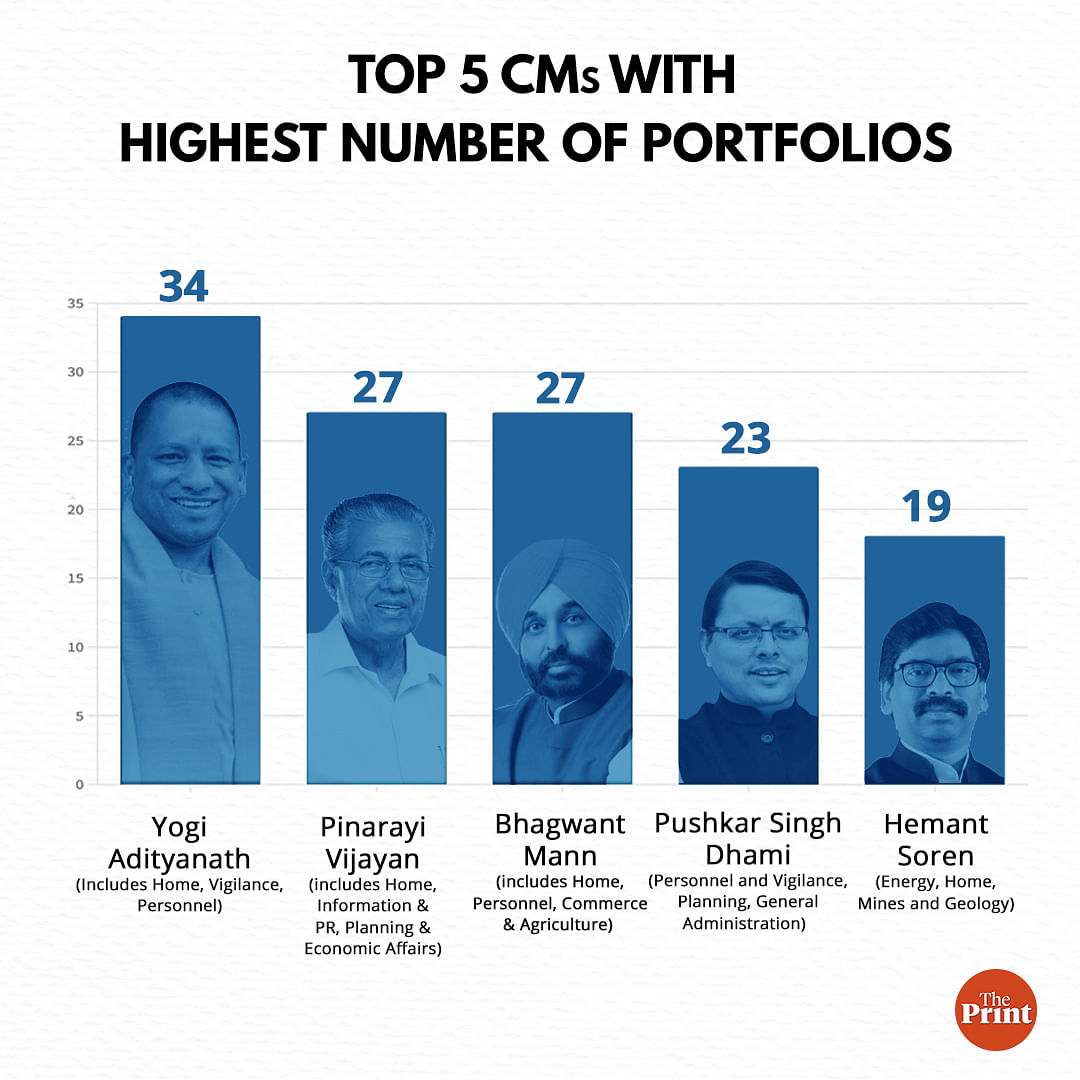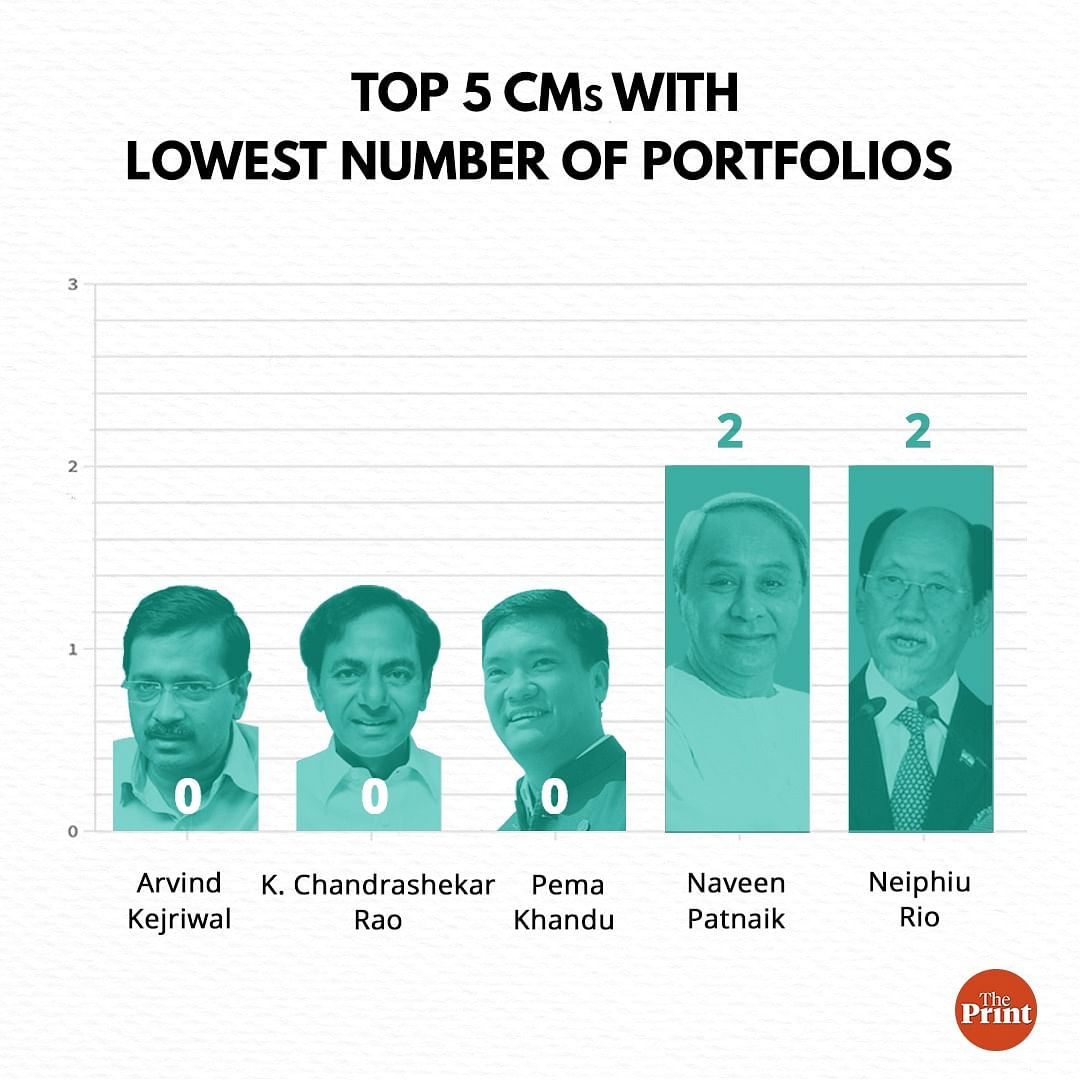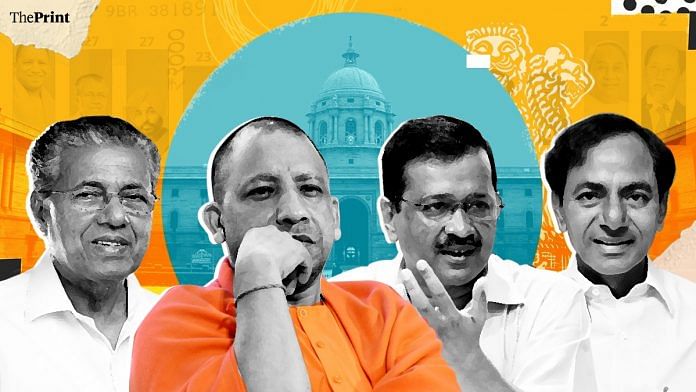New Delhi: BJP’s Yogi Adityanath, CPM’s Pinarayi Vijayan and AAP’s Bhagwant Mann may belong to different political hues but they have one thing in common — as chief ministers, they have awarded themselves the maximum portfolios in their states.
Adityanath, sworn in as chief minister of Uttar Pradesh, India’s most populous state, for the second time last month, has kept 34 departments under his charge.
Vijayan, serving his second term as Kerala CM, and Mann, first-time chief minister of Punjab, handle 27 portfolios each.
Likewise, Uttarakhand CM Pushkar Singh Dhami, a BJP member, has awarded himself 23 portfolios, while Jharkhand CM Hemant Soren of the Jharkhand Mukti Morcha (JMM), a Congress ally, holds 19. Haryana CM Manohar Lal Khattar of the BJP holds 16 portfolios, while Rajasthan’s Ashok Gehlot, a veteran Congress leader, handles 10.

What also unites all these chief ministers is the crucial home department, which they all — barring Khattar — have kept under their charge. As many as 17 chief ministers across India handle this portfolio, which gives them direct control over the state police.
So, what is it that prompts a CM to keep the largest share of portfolios for themselves when they have to oversee the functioning of so many other departments and arms of his government? And how do they decide which portfolios to keep?
According to former Maharashtra chief minister Prithviraj Chavan, “a CM handling the maximum number of departments reflects insecurity and a will to control”.
He told ThePrint: “Some CMs prefer to keep 30-40 portfolios and hardly share any power with the cabinet. These are dictatorial personalities who want to keep control over the flock. Even Mr (Narendra) Modi’s government in Gujarat was the same. He worked with a lot of ministers of state and kept most departments with himself.”
Chavan said “nobody can do justice to so many departments”. “You just want to deny other colleagues the opportunity to grow,” he added.
A retired IAS officer, who is a former chief secretary, said “whatever is important in that particular state, the CM would generally like to keep with him/her”.
“For example, industries is an important department in Gujarat, but not so much in Uttar Pradesh. Finance is not a desirable portfolio because of the technicalities involved. It is mostly a function of reallocation and distribution,” the officer added.
On the other end of the spectrum are chief ministers like Delhi’s Arvind Kejriwal (Aam Aadmi Party), Telangana’s K. Chandrashekar Rao (Telangana Rashtra Samithi), and Arunachal Pradesh’s Pema Khandu (BJP), who have kept few to no portfolios with themselves.
Other civil servants pointed out that portfolio allotments also have to do with the size of a state, compulsions of coalition politics, practical reasons, and sensitivity of the department under consideration.
“The number of portfolios a chief minister holds depends on various factors including political background and type of cabinet ministers a CM has at their disposal. It is not a ‘one-size-fits-all’ approach,” a second retired civil servant said.
Also read: Many in race to be Modi’s successor but here’s one who can step into Amit Shah’s shoes
The favoured responsibilities
Portfolios that most CMs like to keep with themselves include home, general administration, vigilance, finance and personnel.
As many as 18 chief ministers have taken charge of general administration, while 11 have kept finance. The personnel department — which deals with recruitment, appointment, promotion and posting of state service officers and All-India Services officers — is held by 14 chief ministers. Six CMs hold both home and finance.
Some chief ministers also keep “all important policies” under their jurisdiction. Vijayan in Kerala, Bhupendra Patel in Gujarat, and Biplab Kumar Deb in Tripura are in charge of this particular portfolio — which PM Modi has also kept with himself.
The PM’s other portfolios include Ministry of Personnel, Public Grievances and Pensions, Department of Atomic Energy, Department of Space, and all others not allocated to any minister.
“Home is the main component of any state government. Most CMs prefer to keep it. In Gujarat, the trend is that the CM keeps a number two, who deals with day-to-day activities pertaining to the home department,” the first retired civil servant quoted earlier said.
“When Modi was the chief minister in Gujarat, he kept Amit Shah (now Union Home Minister) as MoS Home. It is a very important government function that involves law and order and security of the people, and because day-to-day administration can get very busy, the CM as head of the state keeps his most trusted person as number two, who acts on behalf of the CM,” the officer added.
Former Andhra Pradesh chief secretary L.V. Subramanyam talked about the importance of the general administration department that many CMs prefer to keep.
“Mostly, the general administration department deals with the All-India Services officers and is handled by the CM. Centre-state subjects are also held by the chief minister, as well as the planning department. State cabinet ministers anyway have to come back to the CM for approval of any new policy initiatives,” he said.
Some allotments such as finance are said to be driven by practical reasons, and a bid to increase efficiency.
“Finance is a subject central to all departments, so invariably the person who holds the finance portfolio has to interact with all the ministers, and every proposal that is cleared has financial implications,” Subramanyam added. “So, some chief ministers avoid holding finance because it becomes a stumbling block. The number of meetings a CM has to attend also goes up in that case.”
Chief ministers are also wont to keep with themselves geographically and economically important departments. For instance, in Jharkhand, Soren holds the mines and minerals portfolio, while the Gujarat CM has industries. Vijayan has kept with himself coastal shipping and inland navigation.
Also read: Kejriwal’s 9: The key people who work with the Delhi CM & his govt behind the scenes
Some CMs handle few to no portfolios
A few chief ministers stand out for not taking charge of many departments.
In Delhi, Kejriwal has not kept any department with himself. Telangana’s Rao and Arunachal Pradesh’s Khandu also do not hold any portfolio.

Odisha CM Naveen Patnaik of the Biju Janata Dal (BJD) holds only two departments — home and general administration — while Assam’s Himanta Biswa Sarma of the BJP has kept three, home, personnel and public works department.
Talking about the Odisha CM, the second retired civil servant pointed out: “Naveen Patnaik may be happy keeping just two or three departments because he may have some capable ministers in his cabinet. Or, because he has been CM for a long time, he may have inculcated a culture in which he keeps the minimum departments under his charge.”
The former IAS officer mentioned above said a lot depends on the size of the state. “Smaller states have small cabinets, but the number of government departments is more or less the same. So, in any case, one cabinet minister will always have more than one department and even the CM will hold more than one portfolio. This is necessary due to work distribution requirements,” he added.
CMs also like to keep sensitive departments with themselves, particularly in smaller states. Some key infrastructural departments depending on the geography of the state might also be held by the CM, said the retired civil servant.
Chavan, who was Maharashtra CM from 2010 to 2014, pointed to the politics of coalition and non-coalition governments being a factor when it comes to allocation of portfolios.
“There are difficulties in coalitions because if you want to keep control as the leading party of the coalition, then you have to keep home, finance and other key portfolios with the CM. Many chief ministers prefer to keep home and finance with themselves or with core allies,” he said.
“The current Maharashtra CM (Uddhav Thackeray) despite being part of a coalition (Maha Vikas Aghadi) government does not hold any portfolio except law, judiciary and general administration,” Congress leader Chavan added. “When I was CM, it was a coalition government (NCP-Congress) and we did not have either home or finance, which I think was a big mistake that contributed to an unstable government.”
Former two-term Kerala CM Oommen Chandy said handling multiple portfolios was initially manageable for him, but in his second term he gave up home to focus more on general administration and development activities.
“Big or small, every portfolio is important,” he added. “There is scope for good work in every department with the cooperation of employees and the people.”
(Edited by Nida Fatima Siddiqui)
Also read: Punjab CM orders constitution of Anti-Gangster Task Force headed by ADGP-rank officer



